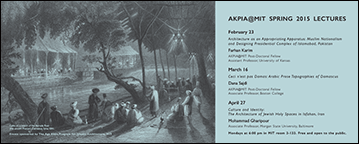Farhan Karim
Architecture as an Appropriating Apparatus: Muslim Nationalism and Designing Presidential Complex of Islamabad, Pakistan
Abstract
The martial government of General Ayub Khan founded Islamabad in 1959, and the design consultancy was commissioned to the Greek firm Doxiadis Associates (DA). After laying out the spatial, infrastructural, and ecological or landscape grid of the city, the Capital Development Authority (CDA), a government organization that oversaw and managed the Islamabad project, invited notable western architects to design the important public buildings. The Presidential complex, which includes the President’s residence, a parliament building and a center for Islamic ideology, was considered as the heart of the city and Louis I Kahn was invited to design the complex. Kahn proposed to transform the Presidential complex from an exclusive premise into a major public place for the city that would celebrate the new country’s collective spirit of Muslim nationalism. Instead of creating a system of symbols to contextualize the project’s Islamic root, Kahn emphasized on symbolic appropriation of landscape – to merge landscape with architecture: architecture morphed into landscape and vice versa to create interconnected and transitory spaces. However this strategy of appropriation appeared too abstract to Pakistani bureaucrats and the CDA eventually found Kahn's design a misfit, a polemic for the overall scheme. Kahn was eventually terminated from the job in 1965, and eventually Edward Durell Stone took the responsibility. Stone’s design appropriated the language of Islamic architecture in a relatively straightforward manner so that the vernacular Islamic motifs, spatial culture and local discourse of Islamic architecture are more clearly legible in modern form. However Stone’s overall design scheme considers the Presidential complex as an exclusive entity, a means to display and exercise the new Pakistani government’s authoritative power. By discussing the evolution of design process of Islamabad’s presidential complex, the talk provides a historical overview of how the urban squares, landscape setting, and new monumental architecture were conceived as an apparatus to appropriate local Islamic discourse and created a visual metaphor of postcolonial national identity.
Biography
Farhan Karim is an assistant professor in the School of Architecture, Design, and Planning (SADP) at the University of Kansas. He received a Ph.D. in the history of architecture from the University of Sydney,
Australia. His first book, Modernism of Austerity: Formation and Display of Ideal Home in India, 1920-1960 is schedule for publication in 2017 from the University of Pittsburg Press. He is now coediting a volume entitled “ Routledge Handbook of Architecture and Social Engagement.” His current research focuses on the involvement of Euro-American architects in the development of modern architecture in postcolonial Pakistan (1947-71). In 2013 he was awarded a Graham Foundation Grant for Advanced Art and Architecture. He also has received the Aga Khan Postdoctoral Research Fellowship at the Massachusetts Institute of Technology for 2015. He has served as the juror for the National Endowment of Humanities (NEH).
Dana Sajdi
Ceci n'est pas Damas: Arabic Prose Topographies of Damascus
Biography
Associate Professor of Middle Eastern History at Boston College. She has written Barber of Damascus: Nouveau Literacy in the 18th-Century Ottoman Levant (Stanford University Press, 2013, forthcoming in Turkish from Koç University Press); edited Ottoman Tulips, Ottoman Coffee: Leisure and Lifestyle in the 18th Century (IB Tauris, 2008, Turkish translation by Aylin Onacak from Koç University Press); and co-edited with Marle Hammond, "Transforming Loss into Beauty": Essays in Arabic Literature and Culture in Memory of Magda Al-Nowaihi (American University in Cairo Press, 2008). Dana enjoys exploring texts and always wonders about the circumstances that impel people to produce texts and the physical manifestations thereof. The history of an 18th-century a barber led Dana to discover a continuous tradition of Arabic descriptions of Damascus between the 12th-20th centuries. She is now plunged in this tradition and came to the AKPIA to learn about landscape and buildings in and beyond texts.
Mohammad Gharipour
Culture and Identity: The Architecture of Jewish Holy Spaces in Isfahan, Iran
Abstract
The city of Isfahan, one of the earliest Jewish settlements, was probably established at the time of deportations of Jews by the Neo-Assyrian and Neo-Babylonian kingdoms in the first millennium bce. The Jewish quarter in Isfahan, which was in proximity to the Friday Mosque, housed the majority of Jews as well as their synagogues. The Jewish community, their history, traditions, art, and other aspects of social life have been the subject of contemporary research, yet their houses and places of worship have not been seriously studied as part of the history of the city. This paper explores the design of synagogues in the Jewish neighborhood of Isfahan by examining the physical and non-physical links between the city and synagogues dating from the nineteenth century. This research, which is founded on formal and spatial analysis of specific case studies as they appear today, aims to show how synagogues reflect the culture of the minority Jews at macro and micro scales, from the city to the interior.
Biography
Mohammad Gharipour is Associate Professor at the School of Architecture and Planning at Morgan State University in Baltimore, USA. He obtained his Master’s in architecture from the University of Tehran and his PhD in architecture and landscape history at Georgia Institute of Technology. He has received the Hamad Bin Khalifa Fellowship in Islamic Art, the Spiro Kostof Fellowship Award from the Society of Architectural Historians, and the National Endowment in Humanities Faculty Award, and publishes extensively on architectural history.
Gharipour has authored and edited several books including the following: Bazaar in the Islamic City (American University of Cairo Press, 2012), Persian Gardens and Pavilions: Reflections in Poetry, Arts and History (I.B. Tauris, 2013), Calligraphy and Architecture in the Muslim World (Edinburgh University Press, 2013), Sacred Precincts: The Religious Architecture of Non-Muslim Communities across the Islamic World (Brill, 2014), and The City in the Muslim Word: Depictions by Western Travelers (Routledge, 2015), and Historiography of Persian Architecture (Routledge, forthcoming). Gharipour is the director and founding editor of the International Journal of Islamic Architecture.
